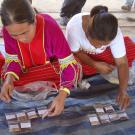This presentation focuses on the successes and impacts of the Horticulture Innovation Lab as of 2014 and was delivered by Amanda Crump of the Horticulture Innovation Lab management team at UC Davis. It includes project successes, horticultural assessments, and impact evaluations from the past year, including several pilot project successes and training achievements.
Gender policy analysis
The presentation also describes the key findings from a policy analysis of women in horticulture completed by students at the University of Minnesota Humphrey School of Public Affairs, in association with the Horticulture Innovation Lab. The study examines policy-related constraints for women in horticulture in four countries:
- Guatemala
- Nepal
- Tanzania
- Zambia
The presentation identifies key findings in four topics:
Female representation: In each of the four study countries women continue to be underrepresented in critical areas of society. Few women are elected to government positions. Quotas may serve to increase the number of women in government but do not ensure that women appointed to reserved seats accurately represent the views of rural and low-income women or that female officials play an active role in decision-making. While countries have made progress in closing the gender gap in primary school enrollment, females lag behind their male counterparts in secondary and tertiary education enrollment. Lower literacy rates and levels of formal education may preclude women taking on leadership roles in their communities.
Skills-based training extension services: These services provide producers with education and assistance that allows them to increase yields, improve produce quality, identify markets, and boost income. Access to extension services and other skill-based training is limited for many rural women. Barriers inhibiting women’s equal participation include geographic location, time and mobility constraints, relevance of content, and the predominance of male extension officers.
Land tenure and inheritance: Even where laws affirm women’s rights to land ownership their access to land may be hindered by other factors. Cultural traditions, societal norms, history, religion, and customary law influence land inheritance producing complex webs of regulation and practice.
Access to credit and financial services: The financial services offered by commercial banks often remain out of reach for rural women. These women face challenges in obtaining credit because of geographic location, poor infrastructure, low financial literacy, and lack of sufficient collateral. Microfinance institutions are growing in number but have made only moderate progress in improving financial inclusion.
The presentation also highlights the following areas from the gender analysis: legal information and services, training and technology, organizations and cooperatives, financial services, and market access.
Other impacts and evaluation
The presentation also describes the status of monitoring and evaluation activities and goals for the Horticulture Innovation Lab. It also highlights accomplishments from three more previously completed projects in Asia related to training of postharvest experts, indigenous seed systems, and coatings for fruit.
This presentation was part of the Horticulture Innovation Lab 2014 Annual Meeting, which took place March 17-21, 2014 in Tegucigalpa, Honduras.

